2017
November
24-30
|
What politics should and should not be
A recent Facebook posting of mine...
Politics ought to be the careful consideration of facts and values in order to make wise decisions about how to run the government.
For many Americans, for the past 2 years or so, politics has not been like that. It has mostly been about passing around pictures with slogans on them ("memes") or even false facts ("Congressmen get $174k for life"), through the gossip mill, without fact-checking or deep thought.
Either that has died down, or I've unfriended all the people who do it, I can't tell which.
We now know that a lot of that gossip was being fed to us by Russian propagandists. I urge everyone to get away from gossip, slogans, and trash-talk, pay close attention to facts, and try to be wise. It's your civic duty.
Feel free to share this.
Permanent link to this entry
Not gone, not forgotten
I continue to neglect the Daily Notebook to devote more effort to revising
Digital SLR Astrophotography and to consulting work, which is going
very well. More news here in December.
And I'm again attempting to get a new laptop. Recall that in March, I briefly
moved from my Lenovo Z570 (which was on its third keyboard and second touchpad and
hard disk) to a Lenovo Z50, which was very similar.
Unreliable Ethernet in the Z50 caused me to give up and return it.
Still, I like Lenovo, and now I have a Lenovo Ideapad 320.
That means I'm moving up from a 15-inch to a 17-inch screen, as well as
quad-core CPU. I've done a week of "soft start" where I use the
new laptop regularly but have not moved the programs and data that can
only be on one computer at a time. I'm writing this blog entry on
the new laptop. So far so good...
Permanent link to this entry


|
2017
November
21-23
|
Telescope dovetail safety screw extender
When it has a heavy camera on the back, my telescope needs to sit
farther forward in the saddle than the rear safety screw will let it.
So I devised an extender for the rear safety screw.
Here you see how it's built and how it looks in use.
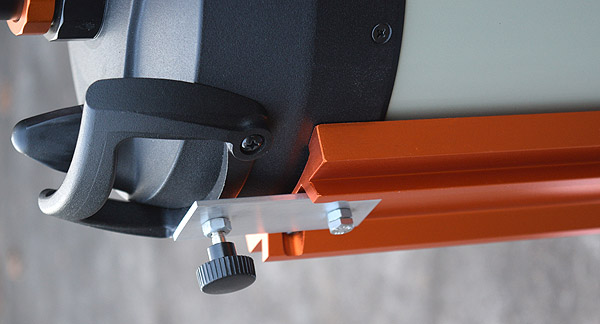
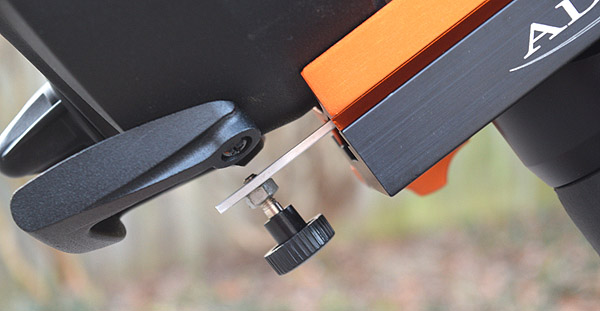
It need not be especially strong because it doesn't hold the telescope in the
mount; it just keeps the telescope from sliding far enough that the saddle
couldn't hold it.
I used aluminum, but wood would do.
Permanent link to this entry


|
2017
November
14-20
|
Thanksgiving Week
I'm devoting my available writing time to Digital SLR Astrophotography (second edition),
not the Daily Notebook. But I do want to acknowledge Thanksgiving...
...and this year, we have many things to thank God for, among them:
- After a year punctuated with medical crises, Melody continues to recuperate. She now does all
her own driving. She still uses a walking stick (and, in large stores, a scooter; and when
carrying things in the house, a rolling walker) but getting her strength back is just
a matter of time. I am glad to have her back!
- Sharon is also getting steadily healthier and was able to go to Atlanta to visit friends
for a couple of days just now.
- Cathy has a new job teaching art to beginners and is very happy with it.
- The grandchildren are thriving, and in particular, Mary (almost 5) treats Emily (1) as her
baby!
During Sharon's trip, Melody and I had a 2-day stay-at-home vacation, during which I did no work.
It's very rare for me to go that long without working. I got some good rest.
Permanent link to this entry
Technical changes at Covington Innovations
A couple of weeks ago, we retired Pallas, the desktop computer we had been using as a file
server since (I think) 2011. Its server functions were moved to my Dell quad-core desktop,
Philothea, which was rechristened Pallas to simplify the network.
In the background of this is the fact that I've found the best way to run Linux is in
VirtualBox under Windows. It has complete file and even clipboard interoperability.
Unlike Bash for Windows, it has a GUI, and unlike a dual-boot system, it doesn't interfere
with Windows (hence Pallas' server functions are not interrupted).
Decommissioning Pallas led to a rearrangement of the work area. We also decommissioned
a color laser printer that had long ago ceased to print color properly.
That made a lot of room. Minerva the Retrocomputer (which triple-boots Linux, Windows XP,
and DOS with Windows 3.1) has moved to Melody's old desk, where Pallas was, and is now
a working Windows XP system. For lack of PCI slots, it is Minerva, not the new Pallas,
that has the Nikon Coolscan III slide and film scanner (whose SCSI card requires a slot).
Our venerable old HP sheet-fed scanner is also on Minerva.
(The long-term plan here is to convert Melody's old office/studio into something more suited
to our present needs. She retired from graphic design quite a while ago, and although the
room will remain to some extent an art studio, she no longer needs a typesetting workstation
or high-resolution printer. We can compact things just a bit.)
To move the Coolscan III to the new Pallas, I would have needed either a PCI Express SCSI card
with the right connector, or a USB SCSI adapter. Either one would cost over $100.
And the Coolscan III is due for an internal
cleaning and lubrication fairly soon, probably within a couple of years. And it has a bit depth
of only 10 (in film terms, D=3.0), which is just adequate.
But I happened to find a freshly serviced Coolscan IV on eBay. This is essentially the same
machine, taking the same film holders, but attached by USB rather than SCSI.
And its bit depth is 12, which
is plenty for photographic film (D=3.6). Right now both Coolscans are in service, on different
computers.
The Coolscans and flatbed scanners (Pallas also has a small one) are all are used with
Vuescan (www.hamrick.com), rather than their own software;
Vuescan supports all scanners regardless of operating system, and a single license is good
for one user on more than one computer.
You can see where this was leading — Pallas needs more USB ports. But since this is the
era of USB, Pallas is rather short of internal slots. It has one full PCI slot
(occupied by the graphics card I added) and one PCIe slot. So I bought a quad USB-3 adapter
for the PCIe slot...
...and I put it in and it works, but it still wants an additional power connection (through a SATA
power cable) to be able to deliver fully rated 5-volt power to USB devices. This is not an urgent
need — it's a desktop, and the USB devices around it are mostly self-powered — but I want to do things
properly, and for that purpose I had to order a SATA power cable splitter, which will be here
Wednesday.
Meanwhile, Pallas (without hard disk), the old HP CP1518ni color printer, and sundry other pieces
of computer hardware went to Free IT Athens,
which refurbishes old computers and sells them
very cheaply to people who can't afford new ones. This is going to continue.
And yes, this entry is very much like the late Jerry Pournelle's "Notes from Chaos Manor."
May his memory be eternal.
Permanent link to this entry


|
2017
November
8-13
|
Celestron AVX declination axis freezes
when installing saddle or at other times
Major revision, February 2019
Introduction: There are a couple of reasons the declination axis of the Celestron AVX mount
may be too stiff or completely freeze up. (It is supposed to be stiffer than other mounts, but not extremely so.)
If it freezes only when you tighten the counterweight bar lock nut,
then skip to Step 4 below. Otherwise start at the beginning of my story.
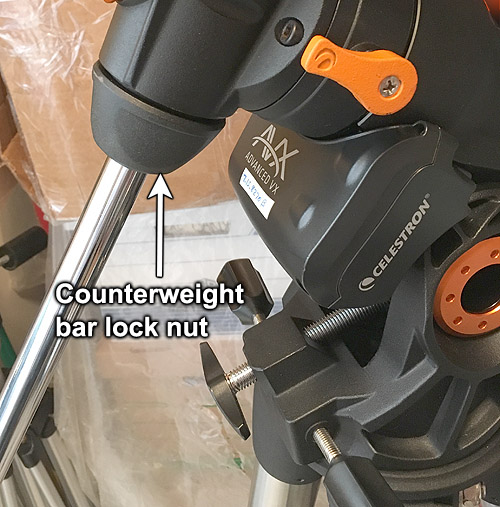
The other day I installed an
ADM dual saddle
on my
Celestron Advanced VX (AVX)
equatorial mount and encountered a strange symptom:
When I fully tightened the 4 screws under the saddle,
the declination axis became extremely stiff or completely
unmovable.
Normally it is supposed to be about 2 to 3 times as stiff
as that of a CGEM because it doesn't have the same type of
bearings.
But not frozen stiff!
First I checked the plastic ring that serves as a bearing at the top
of the declination axis (to keep the saddle, which moves, from contacting
the outer casting, which doesn't).
It was there, doing its job.
See Don Halter's
posting on Cloudy Nights; he had the same problem and attributed it
to excessive thickness of the plastic ring.
In his case, removing the plastic ring cured it. Not in mine.
But then I thought about it a while.
What if the essence of the problem is that the whole declination axis is sitting a bit too low
in the outer casting? By "low" I mean "away from the saddle."
Then tightening down the saddle would compress the plastic ring and keep it from
working properly as a bearing.
I flipped the mount head upside down, removed the counterweight bar, and had a look.
There, a retaining ring (tensioner) holds the declination axis in place.
The retaining ring is secured to the declination axis by two set screws so that you
can tighten it just enough and then lock it in place.
Well, it was too tight. The set screws had come loose, allowing the retaining ring
to rotate freely. Then, whenever I tightened the counterweight bar lock, I was also
tightening the retaining ring. Miraculously, I didn't tighten it enough to make the mount
freeze — until I replaced the saddle and took up all the slack at the other
end of the axis.
Cure?
Step 1: Make sure both set screws are loose (mine already were). There are two,
opposite each other. Use a 1.5-mm hex wrench.
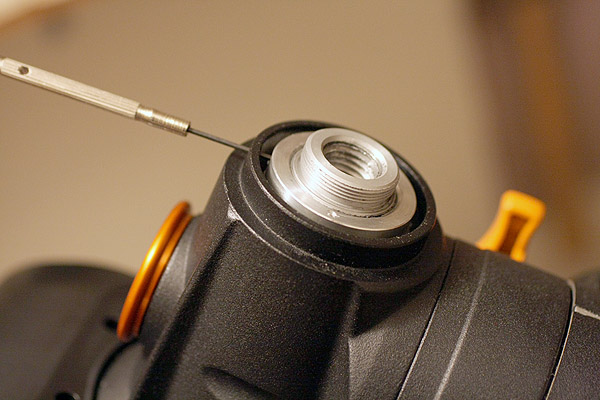
Step 2: Loosen the retaining ring, then re-tighten it moderately tight, not super-tight.
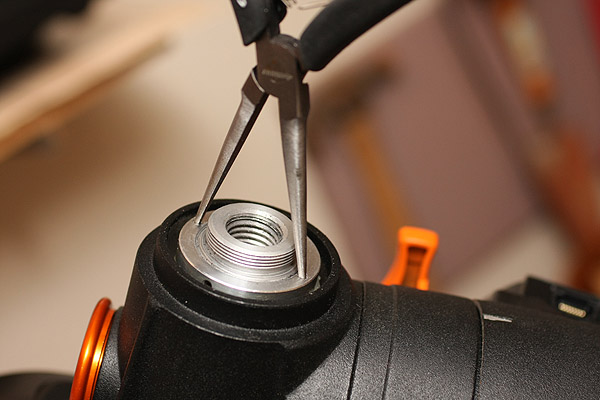
Step 3: Re-tighten the set screws, good and tight. They have a job to do.
Note: Tighten them equally, or you can pull the axis off center.
If the declination axis becomes stiffer as you tighten the set screws, you've put one of
them farther in than the other.
Step 4: Add washers so that the counterweight bar lock nut (big black nut) cannot apply torque
to the retaining ring or bind against the mount housing.
The solution that I'm presenting here was devised by
user "wcoastsands" on the Cloudy Nights Forum.
The photos are my own and are more or less self-explanatory:
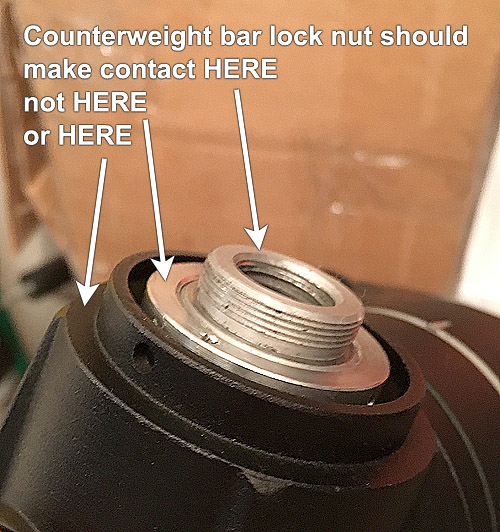
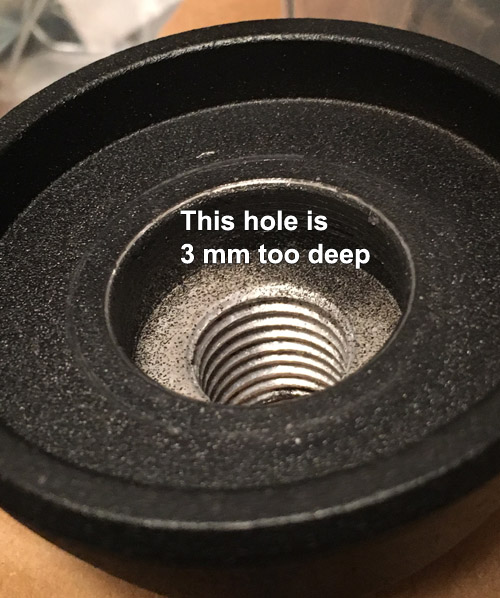
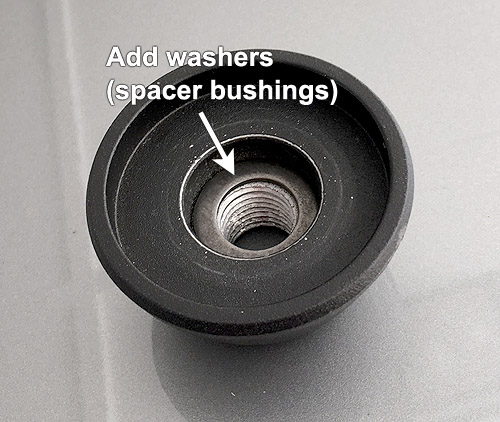
I should emphasize that all this probably depends on how your declination axis is adjusted,
so that many of them have no problems, although it is not good that the big black lock nut can turn the
retaining ring.
The washers you need are 16 mm (5/8 inch) in the center, no more than 26 mm (1 inch) in outside
diameter, and a total of 3 mm thick (for my mount; yours may differ).
I used two of the following spacer bushing, which I got from Home Depot:
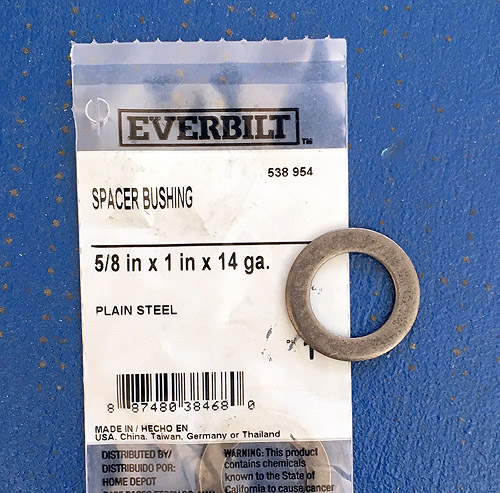
Here's an Amazon link
for the same item.
Another suitable washer is known as an M16 oil drain gasket and is used on the
oil drain of a few cars and motorcycles, but it's an uncommon size.
The thickness that I needed was more than one washer could provide, so I stacked two.
You can glue the washers in place using contact cement if you remove your counterweight bar
often and are afraid of losing them.
In 2017 I published a less satisfactory solution that used a lubricated washer to keep the big black nut from
tightening the retaining ring. Here are my pictures from then:
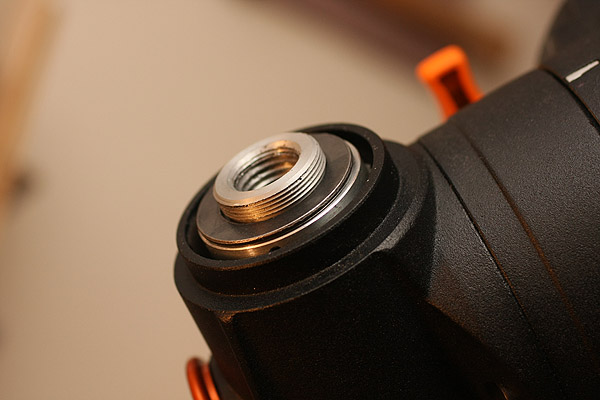 —
—

Addendum:
When the retaining ring at the bottom of the
declination axis is adjusted correctly, the plastic ring at the
top, just under the saddle, is not load-bearing at all.
It is maybe 0.1 mm lower than the inner, revolving declination axis.
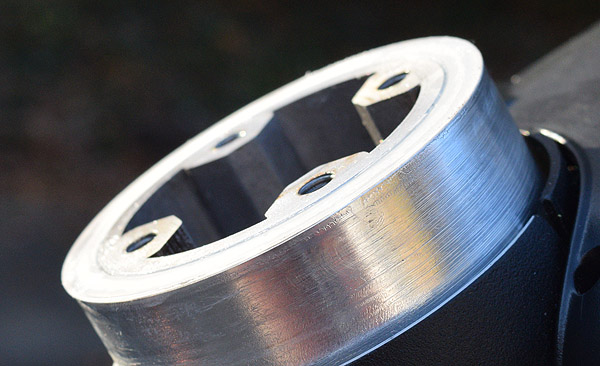
The dimensions I measured for the plastic ring are: o.d. 75 mm (maximum),
i.d. 62 mm (minimum), thickness about 0.7 mm, not critical, as thin as practical
(and adjust the retaining ring after replacing it).
Permanent link to this entry


|
2017
November
1-7
|
Please pardon my absence...
Nothing is wrong, but I'm busy writing the second edition
of Digital SLR Astrophotography, and doing other
important work, rather than writing Notebook entries.
Permanent link to this entry
An intelligence test
Here is something I posted on Facebook several days before the Texas massacre,
all the more relevant in the discussions that are now necessary.
Why is it so impossible for some people to rationally consider the following two things at once?
(1) Guns don't kill people by themselves; people kill people.
(2) Guns, especially certain types of guns, make it appreciably easier for people to kill people.
Plenty of people, both those who want to decrease gun control and those who want to increase it, do understand both points. From there it's a matter of gathering facts about where the main hazards lie and how to mitigate them. I can have worthwhile conversations with everyone in that set.
But I have been running into people who find it just impossible to consider items (1) and (2) at the same time. It's as if I were asking them to calculate a 4-dimensional matrix rotation in their heads. They get angry and spout illogical nonsense.
Or else they feel they are forbidden to admit that one of them is true (usually the second one),
that if they do, they're surrendering to the opposing side, as if logic were a war or a football
game, where if there are two propositions, they cannot both be true;
one has to win and the other has to lose.
A related point: Annoyingly, some people wade into any discussion
of gun control and start railing loudly against
some unreasonable position that no one there has actually advocated.
Why? To save themselves the trouble of listening and reasoning?
Permanent link to this entry


|
|
|
This is a private web page,
not hosted or sponsored by the University of Georgia.
Copyright 2017 Michael A. Covington.
Caching by search engines is permitted.
To go to the latest entry every day, bookmark
http://www.covingtoninnovations.com/michael/blog/Default.asp
and if you get the previous month, tell your browser to refresh.
Portrait at top of page by Krystina Francis.
Entries are most often uploaded around 0000 UT on the date given, which is the previous
evening in the United States. When I'm busy, entries are generally shorter and are
uploaded as much as a whole day in advance.
Minor corrections are often uploaded the following day. If you see a minor error,
please look again a day later to see if it has been corrected.
In compliance with U.S. FTC guidelines,
I am glad to point out that unless explicitly
indicated, I do not receive substantial payments, free merchandise, or other remuneration
for reviewing or mentioning products on this web site.
Any remuneration valued at more than about $10 will always be mentioned here,
and in any case my writing about products and dealers is always truthful.
Reviewed
products are usually things I purchased for my own use, or occasionally items
lent to me briefly by manufacturers and described as such.
I am an Amazon Associate, and almost all of my links to Amazon.com pay me a commission
if you make a purchase. This of course does not determine which items I recommend, since
I can get a commission on anything they sell.
|
|













 —
—

